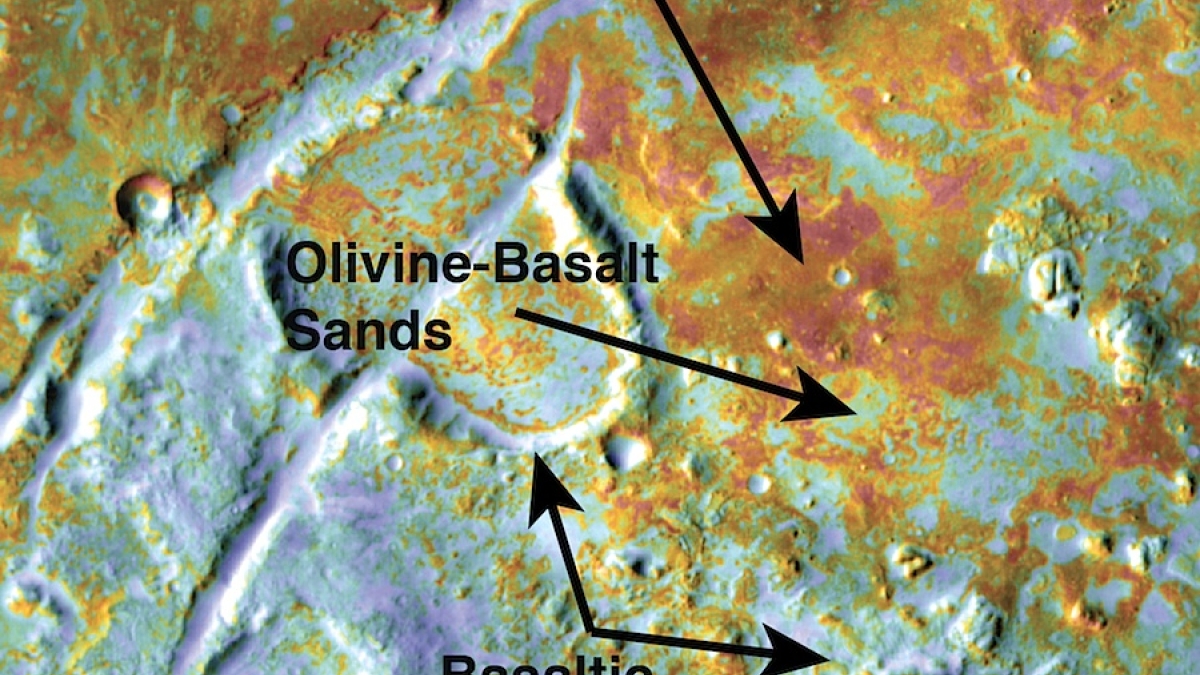ASU instruments help scientists probe ancient Mars atmosphere

An area named Nili Fossae contains the richest deposit of carbonate minerals on Mars. If the carbon dioxide in its rocks were released, it would about triple the density of Mars' present atmosphere. New work using data from ASU instruments and others on NASA orbiters suggests that either Mars has yet-undiscovered reservoirs of carbonate rocks — or the planet may have seen flowing water despite having a thin, cold atmosphere. This THEMIS image uses false colors to show where the surface has loose materials such as sand or gravel (cool colors) and where the ground is tougher and rockier (warm tones). The scale bar is 12 miles long.
Photo by: NASA/JPL-Caltech/Arizona State University
Mars was not always the arid Red Planet that we know today. Billions of years ago it was a world with watery environments — but how and why did it change?
A new analysis of the largest known deposit of carbonate minerals on Mars helps limit the range of possible answers to that question.
The Martian atmosphere currently is cold and thin — about 1 percent of Earth's — and almost entirely carbon dioxide. Yet abundant evidence in the form of meandering valley networks suggests that long ago it had flowing rivers that would require both a warmer and denser atmosphere than today. Where did that atmosphere go?
Carbon dioxide gas can be pulled out of the Martian air and buried in the ground by chemical reactions that form carbonate minerals. Once, many scientists expected to find large deposits of carbonates holding much of Mars' original atmosphere. Instead, instruments on space missions over the past 20 years have detected only small amounts of carbonates spread widely plus a few localized deposits.
The instruments searching for Martian carbonate minerals include the mineral-detecting Thermal Emission Spectrometer (TES) on NASA's Mars Global Surveyor orbiter and the Thermal Emission Imaging System (THEMIS) on NASA's Mars Odyssey orbiter. THEMIS' strength lies in measuring and mapping the physical properties of the Martian surface.
Both instruments were designed by Philip Christensen, Regents' Professor of geological sciences in ASU's School of Earth and Space Exploration. TES fell silent when NASA lost contact with Mars Global Surveyor in 2006, but THEMIS remains in operation today.
"We designed these instruments to investigate Martian geologic history, including its atmosphere," Christensen said. "It's rewarding to see data from all these instruments on many spacecraft coming together to produce these results."
Other instruments involved in the search include the mineral-mapping Compact Reconnaissance Imaging Spectrometer for Mars and two telescopic cameras on NASA's Mars Reconnaissance Orbiter.
Big, but not big enough
By far the largest known carbonate-rich deposit on Mars covers an area at least the size of Delaware, and maybe as large as Arizona, in a location called Nili Fossae. But its quantity of carbonate minerals comes up short for what's needed to produce a thick atmosphere, according to a new paper just published online in the journal Geology.
The paper's lead author is Christopher Edwards, a former graduate student of Christensen's. He is now with the U.S. Geological Survey in Flagstaff, Arizona. Both TES and THEMIS contributed to the work, he said.
"The Thermal Emission Spectrometer told us how much Nili has of several kinds of minerals, especially carbonates," Edwards noted.
And, he added, "THEMIS played an essential complementary role by showing the physical nature of the rock units at Nili. Were they impact-shattered small rocks and soil? Were they fractured and cemented rocks? Or dunes? THEMIS data let us differentiate these units by composition."
Bethany Ehlmann of the California Institute of Technology and NASA's Jet Propulsion Laboratory is Edwards' co-author. She said Nili doesn't measure up to what's needed. "The biggest carbonate deposit on Mars has, at most, twice as much carbon within it as the current Mars atmosphere.
"Even if you combined all known carbon reservoirs together," she explained, "it is still nowhere near enough to sequester the thick atmosphere that has been proposed for the time when there were rivers flowing on the Martian surface."
Edwards and Ehlmann estimate that Nili's carbonate inventory, in fact, falls too short by at least a factor of 35 times. Given the level of detail in orbital surveys, the team thinks it highly unlikely that other large deposits have been overlooked.
Atmosphere going, going, gone
So where did the thick ancient atmosphere go?
Scientists are looking at two possible explanations. One is that Mars had a much denser atmosphere during its flowing-rivers period, and then lost most of it to outer space from the top of the atmosphere, rather than into minerals and rocks. NASA's Curiosity Mars rover mission has found evidence for ancient top-of-atmosphere loss, but uncertainty remains just how long ago this happened. NASA's MAVEN orbiter, examining rates of change in the outer atmosphere of Mars since late 2014, may help reduce the uncertainty.
An alternative explanation, favored by Edwards and Ehlmann, is that the original Martian atmosphere had already lost most of its carbon dioxide by the era of rivers and valleys.
"Maybe the atmosphere wasn't so thick by the time the valley networks formed," Edwards suggested. "Instead of Mars that was wet and warm, maybe it was cold and wet with an atmosphere that had already thinned."
How warm would it need to have been for the valleys to form? It wouldn't take much, Edwards said.
"In most locations, you could have had snow and ice instead of rain. You just have to nudge above the freezing point to get water to thaw and flow occasionally, and that doesn't require very much atmosphere."
The School of Earth and Space Exploration is a unit of ASU's College of Liberal Arts and Sciences.
More Science and technology

SPARCS mission spacecraft bus delivered to ASU for final assembly
The Arizona State University team that is building the NASA-funded Star-Planet Activity Research CubeSat, or SPARCS, cleared a…

Associate professor shares her journey from NASA to ASU
From leading space missions to designing and building spaceflight hardware and training students in space science and engineering…

Famed systems engineer inspires ASU to tackle global problems
“Providing great talent with great opportunity can make a great difference.” Such was a key part of the message delivered by G.…